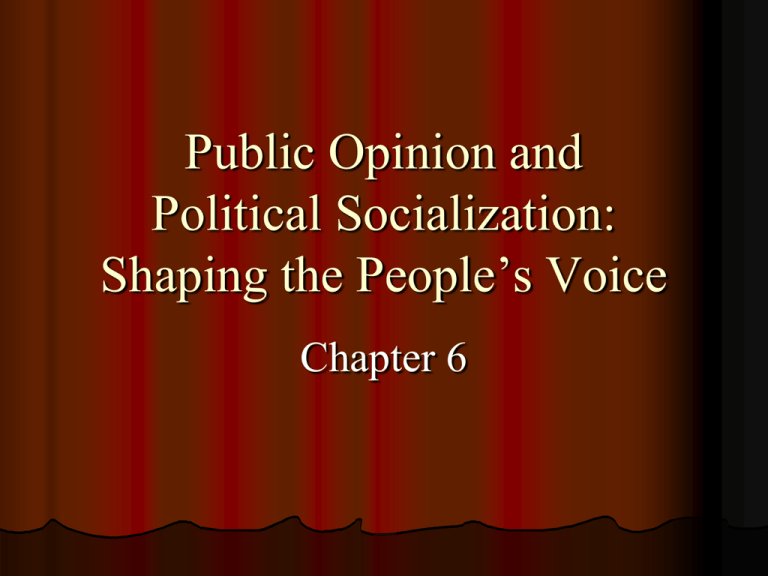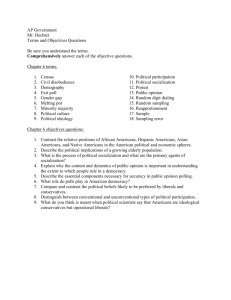
Public Opinion and
Political Socialization:
Shaping the People’s Voice
Chapter 6
Political Socialization:
The Origins of Americans’ Opinions
Public opinion: opinions of citizens that are
openly stated
Political culture: the characteristic and deepseated beliefs of a particular people about
government and politics
© 2011, The McGraw-Hill Companies, Inc. All Rights Reserved.
2
Political Socialization:
The Origins of Americans’ Opinions
Political socialization process
Childhood
learning is paramount
Process is cumulative: political affiliations usually
grow firmer with age
© 2011, The McGraw-Hill Companies, Inc. All Rights Reserved.
3
Political Socialization:
The Origins of Americans’ Opinions
Primary political socialization agents
Family
Family
is the strongest of all agents of socialization
Schools
Church
Scholars
have not studied the effects of religion as well
as schools or family, but it is a powerful influence
© 2011, The McGraw-Hill Companies, Inc. All Rights Reserved.
4
Political Socialization:
The Origins of Americans’ Opinions
Secondary political socialization agents
Peers
Media
Leaders
© 2011, The McGraw-Hill Companies, Inc. All Rights Reserved.
5
Frames of Reference: How
Americans Think Politically
Frames of reference: reference points by which
individuals evaluate issues and developments
Party identification
Party
identification: emotional loyalty to a political
party; not formal membership
Major shifts in loyalty rare and in younger adults
Can lead to selective perception
© 2011, The McGraw-Hill Companies, Inc. All Rights Reserved.
6
Partisanship and Issue Opinions
© 2011, The McGraw-Hill Companies, Inc. All Rights Reserved.
7
Frames of Reference: How
Americans Think Politically
Political Ideology
A
coherent set of political beliefs
Few Americans have true political ideology
Ideological leanings:
Economic
liberals/conservatives
Social liberals/conservatives
Populists and libertarians
© 2011, The McGraw-Hill Companies, Inc. All Rights Reserved.
8
Frames of Reference: How
Americans Think Politically
Group orientations
Religion
Economic
class
Region
Race
and ethnicity
Gender
Generations and age
Crosscutting cleavages
© 2011, The McGraw-Hill Companies, Inc. All Rights Reserved.
9
Gender and Military Conflicts
© 2011, The McGraw-Hill Companies, Inc. All Rights Reserved.
10
The Measurement of Public Opinion
The measurement of public opinion
Traditional
method: election results
Public opinion polls: primary method
Measure
public opinion using randomly chosen
population sample(s) and carefully constructed
interviews
of population’s views
Accuracy of a poll—expressed by sampling error
Samples—estimation
© 2011, The McGraw-Hill Companies, Inc. All Rights Reserved.
11
The Measurement of Public Opinion
Problems with polls
Increasing
refusal to participate in telephone polls
Polled individuals unfamiliar with issues
Dishonesty by respondents
Poorly worded questions and poor question order
Non-opinions
© 2011, The McGraw-Hill Companies, Inc. All Rights Reserved.
12
The Influence of Public Opinion
on Policy
Disagreement over how much public opinion
affects policy, and how much it should affect
policy
Limits on public influence
Inconsistencies in
citizens’ policy preferences
Citizens’ lack of understanding of issues
Mastery
of issues not necessary for opinion to be of
value, but some issues require understanding
© 2011, The McGraw-Hill Companies, Inc. All Rights Reserved.
13
The Influence of Public Opinion
on Policy
Public opinion and the boundaries of action
Some
policy actions outside boundaries of public
acceptability
Greater the level of public involvement, the more
likely officials will respond to public sentiment
Even on popular issues, leaders have some
discretion
Leaders can influence public opinion through
concerted effort
© 2011, The McGraw-Hill Companies, Inc. All Rights Reserved.
14




